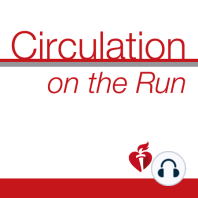16 min listen
Circulation February 23, 2021 Issue
ratings:
Length:
19 minutes
Released:
Feb 22, 2021
Format:
Podcast episode
Description
This week, join author Chintan Dave and Associate Editor Naveed Sattar as they discuss the risk of cardiovascular outcomes in Type 2 Diabetes patients following the addition of SGLT2 inhibitors versus sulfonylureas to baseline GLP-IRA therapy. TRANSCRIPT BELOW: Dr. Carolyn Lam: Welcome to Circulation on the Run, your weekly podcast, summary, and backstage pass to the journal and its editors. We're your co-hosts, I'm Dr. Carolyn Lam, Associate Editor from the National Heart Center and Duke National University of Singapore. Dr. Greg Hundley: And I'm Dr. Greg Hundley, Associate Editor, director of the Pauley Heart Center at VCU Health in Richmond, Virginia. Dr. Carolyn Lam: Greg, I love today's featured paper. It's a question everybody's asking. It's about cardiovascular outcomes, potential benefits, following the addition of SGLT2T2 inhibitors versus sulfonylureas to baseline GLP-1 receptor agonist therapy. Now, okay, I'm going to keep you waiting because that was just a hook. We got to get to us summaries first. And I'm going to start. The first original paper I want to describe is an analysis of myocardial infarction from the ischemia trial. And it looks at the impact of different definitions on the incidents, prognosis and treatment comparisons. Dr. Carolyn Lam: Because I know you're going to ask, I'm going to tell us a little bit about ischemia. So in an ischemia and initial invasive strategy did not significantly reduce rates of cardiovascular events or all-cause mortality compared with a conservative strategy in patients with stable ischemic, heart disease, and moderate to severe myocardial ischemia. The most frequent component of the composite cardiovascular end points was myocardial infarction. So in the current report from Dr. Chaitman and colleagues from St. Louis University school of medicine, the aim was to compare treatment effects on the primary and major secondary competent end points in the ischemia trial using the pre-specified primary and secondary MI definitions. Dr. Greg Hundley: So Carolyn, what were those two EBI definitions, the primary and secondary? Dr. Carolyn Lam: Right. Now, I'm going to try to simplify this. So, for procedural MI, the primary MI definition use CK-MB as the preferred biomarker, whereas the secondary definition used cardiac troponin. Dr. Greg Hundley: Great, Carolyn. So what did they find? Dr. Carolyn Lam: So procedural MI definition had an important impact on event frequency and subsequent prognosis. When the pre-specified secondary MI definition was applied, the conservative strategy had a significantly lower composite event rate for the primary and major secondary trial end points, due to an increased number of procedural MIs in the invasive strategy. Furthermore, spontaneous Type One MI events associated with increased risk of cardiovascular death were reduced with an invasive strategy, which is either PCI or CABG. Dr. Greg Hundley: Nice, Carolyn. Well, my first paper actually is a favorite topic of yours, HFpEF. And it really involves the central command and the regulation of exercise rate response. It comes to us from Dr. Ben Levine and colleagues at the University of Texas Southwestern Medical Center in Dallas. Dr. Carolyn Lam: Yay. Dr. Greg Hundley: All right, Carolyn. So chronotropic incompetence is common in HFpEF. And it's linked to impaired aerobic capacity. Whether upstream, autonomic signaling pathways are responsible for raising exercise heart rate are impaired in patients with HFpEF, That's really unknown. Dr. Carolyn Lam: Yep. It is something that we wonder. And so what did Dr. Levine find? Dr. Greg Hundley: Thanks Carolyn. So the central command, so vaguely mediated and the metabo-barrow receptor function, which is sympathetically mediated in patients with HFpEF, We're not different from healthy senior controls, despite significantly lower peak whole body exercise, heart rates. So these results, Carolyn, demonstrate key reflex autonomic pathways, regulating exercise,
Released:
Feb 22, 2021
Format:
Podcast episode
Titles in the series (100)
Circulation June 6, 2017 Issue: Circulation Weekly: Your Weekly Summary & Backstage Pass To The Journal by Circulation on the Run
